Dutch naval air service
[ page 1 ]
Conversion of Lynx model in 1/32 scale of Revell (Mk.88A, kit ref no 04652)
The Revell Lynx helicopter kit in 1/32 was long awaited. The Lynx kit is fine, but first let's look briefly at the Westland Lynx history.
Developed in a joint effort by Westland (UK) and French Aerospatiale, the Lynx is a multi-role helicopter for army and naval use. The naval versions got a wheel undercarriage and the army versions a skid. Prototype flew in 1971 and many versions were developed. The type was used by the British armed forces, France, Germany, The Netherlands, Danmark and many other nations.
The Dutch naval service (Marine Luchtvaart Dienst / MLD ) ordered the Lynx for anti-submarine role, transport, and Search and Rescue (SAR). It replaced the Wasp and Agusta Bells and the Lynx was choosen as it should be able to operate in bad weather in various roles.
The Dutch Lynx
has a lot in common with the British HAS 2/3 type. As with other navies
like the British navy, the MLD helicopters mainly operated from Dutch naval
ships. Their Dutch Lynx designations were:
- UH-14A for
the ”utility” transport helicopter
- SH-14 for
the anti-submarine role, with the SH-14B and the SH-14C equipped with MAD
system which proved to be in fact unusable.
It could be
fitted with a hoist and it was famous for its rescue missions in terrible
weather.
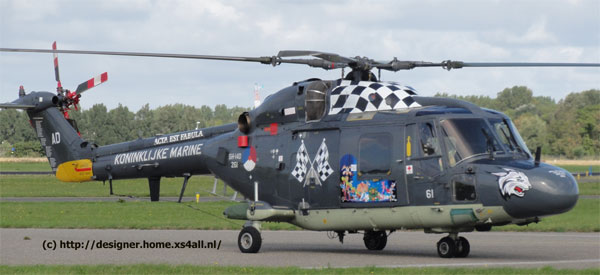
(Dutch
SH-14D at the final farewell ceremony, De Kooij, September 15, 2012; photo
by Meindert de Vreeze)
At the end of 1993, the remaining Dutch Lynx helicopters were standardized to the SH-14D. As Westland did not manufacture metal blades any more, new BERP main rotor blades were installed with their typical curved tips. Also, a new GEM-42 engine was installed. A removable dipping sonar installation was also fitted. The stabilizer was renewed with reduced span and “gurney trailing edge”, but the tailrotor remained unchanged however (contrary to many other newer Lynx variants with the new BERP).
The Dutch Lynxes were put out of Dutch service September 2012 and the type was well liked.
![]()
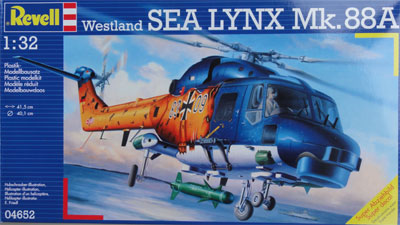 .....
.....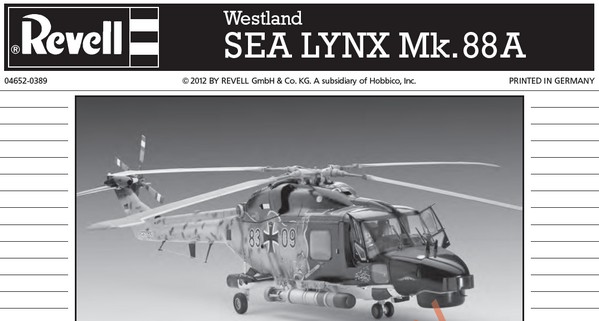
The Revell
kit of the Sea Lynx mk.88A
The Revell kit
is the first Lynx in 1/32 scale. Parts are very fine and the first release
of the kit is for a Mk.88A as used by the German Navy. This version
is different from the Dutch Lynxes, more on that later on.
A conversion is thus needed for Dutch Lynxes.
| NOTE:
February 2013, REVELL issued a different version of this kit, the HAS 3. Using this kit will save you a lot of work for the SH-14D! A comparison between this kit and the German mk.88A kit is presented here.... Also includes step-by-step suggestions. 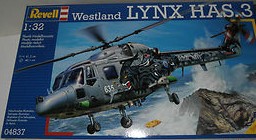 |
The shapes and proportions of the Revell model mk.88A look OK for a naval Lynx. Many of details, with over 270 parts.


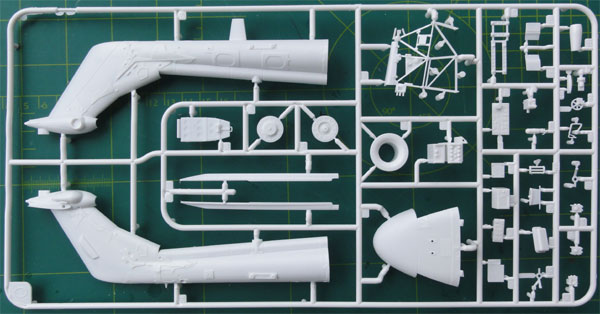

Typical for
the Lynx Mk88A is the nose with a lower search radar fairing.
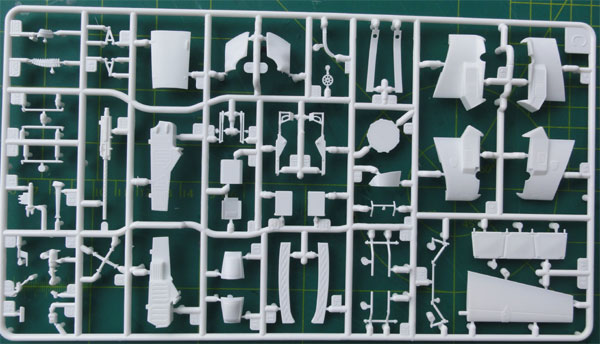
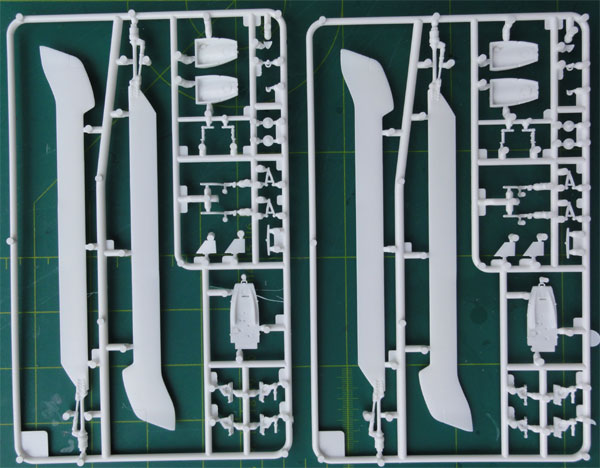
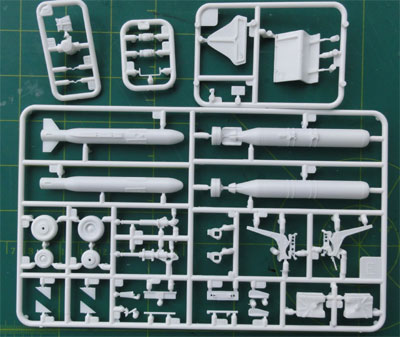 (2x)
(2x)
and parts for
the HMA8, that has some parts for the RN radar and the foldable tail-end.

Decals in the
Revell kit (04652) are for 3 German Lynxes:
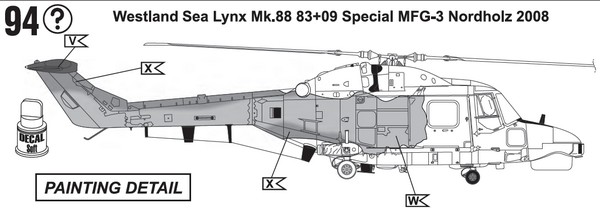

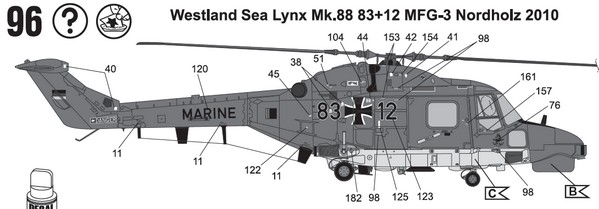

![]()
OK, let us look at some details.
Also, German
Lynxes have ECM pods on the undercarriage stubwings.
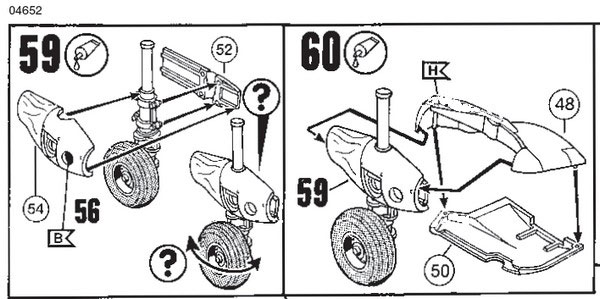
Seats, floor, walls, cabin roof are well detailed. Even the sonar installation and the operator console are included. The outher surfaces are well done but miss rivet details. On a real Lynx these numerous rivets are well visible.
The modern BERP rotorblades are included with parts of a "non folding" tailboom end. Depending on the Lynx version, some fold their tail end.
Within the kit, included is the later style tailrotor of greater diameter (2,36 m). The newer type stabilizer is also included with nicel moulded “gurney flap” trailing edge.
![]()
A Dutch
Lynx model?
![]()
OK, a Dutch
naval air service (MLD) SH-14D was desired in this 1/32 scale, so
some conversion is needed. What work is needed? (also check out the references
below...)
MODEL COMPLETED
FEBRUARY 2013: Largest modifications overview
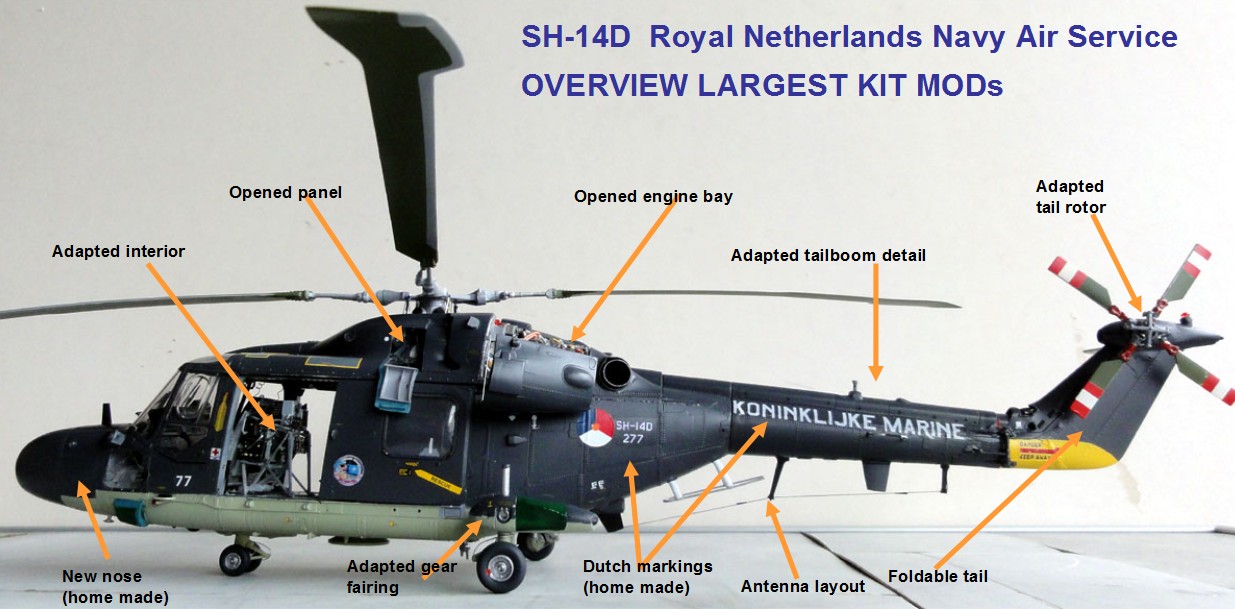
... OK, let's look further with photos I made during the Open Day.....
-1-
the
nose of the Dutch Lynx is different (like the HAS 2/3) . A new nose will
be home made and moulded (see notes later on....)
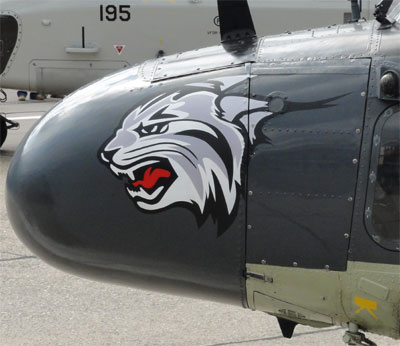
-2-
the initial older style tailrotor is needed. This initial tailrotor rotates
the other direction, has a different inboard cut-out shape and has a smaller
diameter of 2,21 m. Some small conversion work needed here.

-3- the stabilizer span (kit part #58) should be reduced by 14 mm. (NOTE: for an old Lynx version, like the UH-14D, simply sand flat the gurney trailing edge, the kit part span is fine with 50 mm in 1/32 scale).
-4- the Dutch Lynx tailboom end is foldable and has the prominent swivelling mechanism; these should be added.
-5-
no
big ECM fairings are at the undercarriage stubwings. Note however the tiny
RWR antenna

-6- some interior work needed like a different main instrumentpanel. Also a slightly different sonar operator console
-7- various different intake scoops and fairings as well as different antennas
-8- the cabin sliding doors should each have a flat window on a Dutch Lynx.
With the exception
of the new nose (-1-), the rest of the conversion work
can be done with some limited amount of work.
OK, the nose is different for a Dutch Lynx (in fact, very similar to other older versions as well common to HAS 2 / HAS 3).
After looking at the kit parts, it would be great to have multiple noses casted also for future other models. So it was decided to make a new nose and duplicate it with resin.
The best way to fit such a nose would
be to remove the kit nose-bulkhead so only some filling would be needed.
The bulkhead areas to both fuselage halves and the fuselage bottom was
cut from the parts with a razorsaw:

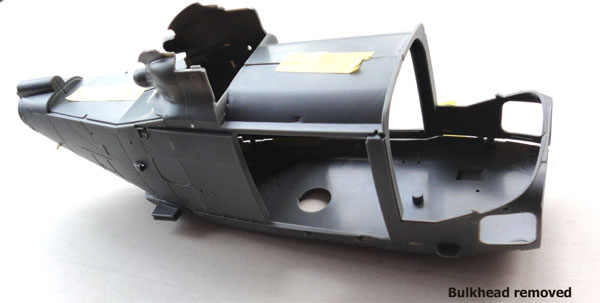
Now, the cross section is clear what the new nose would require.....
Several symmetrical patterns were
made for the new nose. Typical is the curve at the lower surface and more
flat area at the sides. Lots of work was done to make the new nose master.
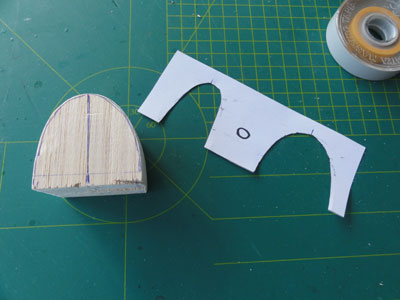
.
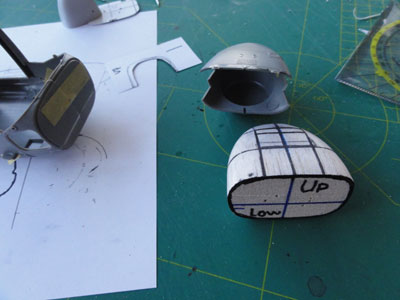 ..
..
When ready with some special tricks, the master was used to create a rubber mould. Also, to avoid a very heavy resin nose, the nose was made in 2 parts. After drying, the new resin nose could be casted.
Result seen here with the 2-part nose:

NOTE: no panel lines are moulded on the nose as these differ on Lynx variant. Re-scribing and adding these later as desired is more flexible. Also, the smaller air holes need some filling, but nothing unusual for the modeller.
![]()
Also it was decided to make two new
stubwings for the main undercarriage as on a Dutch Lynx no large ECM fairings
are seen on the stubwings (see remark -5- ).
 kit
parts
kit
parts
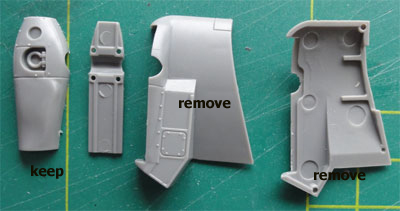
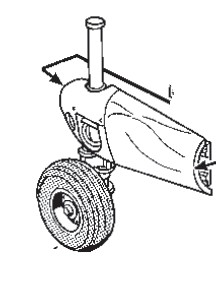
Making new ones with home made resin
casted parts would save a lot of work on future models.
The result with 2 new stubwings:

(Revell part 54 will fit and the gear kit parts can be inserted). Re-scribing of some surfaces can be done as desired and filling any smaller air holes is also needed.
![]()
page 2
page 3
page 4
page 5
page 6
page 7
page 8 (completed)
My own conversion set with the resin parts is SOLD OUT. Sorry!
On to Lynx next
[ page 2....]
References:
IPMS Nederland "Modelbouw in Plastic" magazine: MIP 1984-4 , MIP 2012-2 about Dutch Lynxes
Internet:
- IPMS Nederland MLD Lynx information pages....
- IPMS Nederland Revell Lynx pre-view
- IPMS Nederland Lynx SH-14D Walk Around
Back to 1/32 scale Models.......

(c) Copyright Meindert "designer"/ All rights reserved. Your comments are welcomed by webmaster
Created this page November 2, 2012